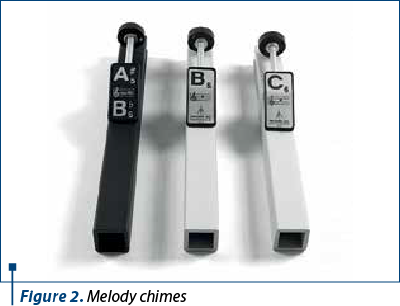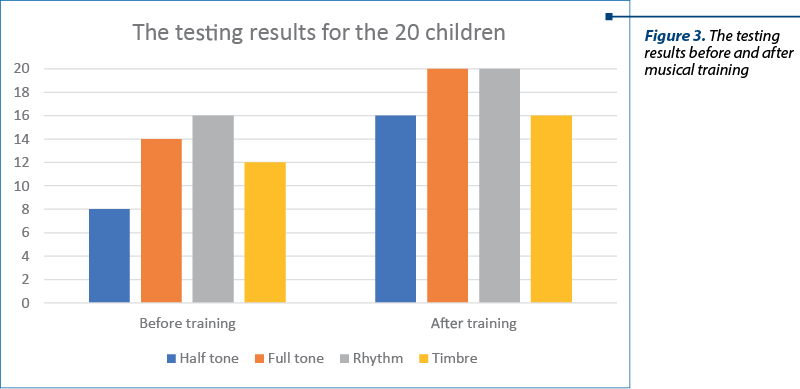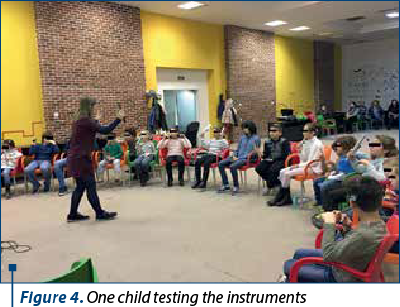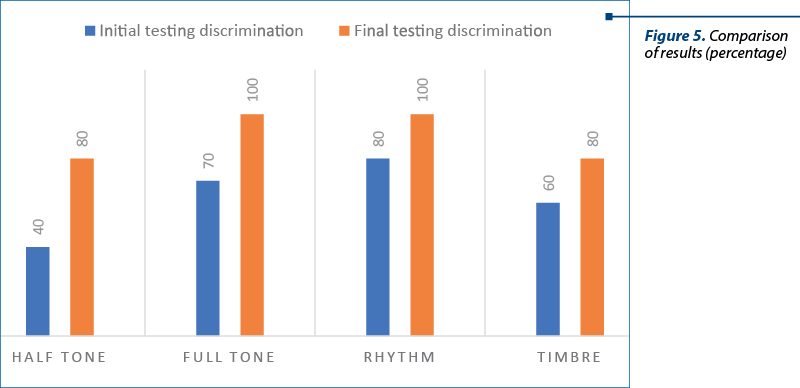The purpose of the study. To directly improve the capacity to discriminate musical sound’s parameters by the cochlear implanted children who participated in the designed training activity. Also, speech recognition in difficult sound environments is indirectly improved. Materials and method. The experimental study was organized as an orchestra of musical bells and melody chimes. The group was represented by 20 cochlear implanted children aged 4 to 17 years old. They participated 6 months for orchestra training. The capacity of all the subjects to discriminate the rhythm, tonality and timbre of the musical sounds was tested before starting the rehabilitative activity and after six months of musical training. Results. After six months of musical training, all the children showed significant improved capabilities of discrimination of sound parameters comparing with the initial testing results. Conclusions. Musical training for cochlear implanted children can contribute to an increased music enjoyment and quality of life for this category of patients, by providing better discriminatory skills regarding musical parameters.
Muzica şi învăţarea perceptivă auditivă – copii implantaţi cohlear, antrenaţi timp de şase luni într-o orchestră de clopoţei muzicali şi chimes melodici
Music and auditory perceptual learning – cochlear implanted children trained six months inside a musical bells and melody chimes orchestra
First published: 04 martie 2021
Editorial Group: MEDICHUB MEDIA
DOI: 10.26416/ORL.50.1.2021.4222
Abstract
Rezumat
Scopul studiului. Îmbunătăţirea directă a capacităţii copiilor implantaţi cohlear de a discrimina caracteristicile muzicale în urma participării la activitatea de recuperare auditivă propusă şi îmbunătăţirea în mod indirect a inteligibilităţii vorbirii în medii acustice dificile. Materiale şi metodă. Studiul experimental a fost organizat ca o orchestră formată din clopoţei muzicali şi chimes melodici. Grupul de studiu a fost format din 20 de copii implantaţi cohlear, care au participat timp de şase luni la activitatea propusă. Am testat capacitatea subiecţilor de a detecta ritmul, tonalitatea şi timbrul sunetelor muzicale, înainte de începerea activităţii şi după şase luni de antrenament muzical. Rezultate. După şase luni de antrenament muzical, toţi copiii au înregistrat progrese semnificative ale capacităţilor de discriminare auditivă. Concluzii. Antrenamentul muzical poate contribui, în cazul copiilor implantaţi cohlear, la creşterea capacităţii de a discrimina corect caracteristicile sunetelor şi de a se bucura de muzică, ceea ce implică o creştere a calităţii vieţii la această categorie de pacienţi.
Introduction
The recent technical performances of cochlear implants allow wearers to successfully connect with the sound environment, but also to enjoy and even play music and have an almost normal hearing life in all types of hearing environments. Music and language imply a similar modulation and processing of the acoustic parameters, but music is spread over a wider spectrum of pitch and sound levels comparing with speech. Also, due to the complex harmonies, music is an acoustic stimulus more difficult to process than language, involving elaborate discrimination mechanisms.
Cochlear implants are technically able to cover all the polyphonic, harmonic and timbral information specific to music (McDermott, 2004).
According to Bruns, Mürbe and Hahne (2016), due to the complexity of musical sounds and to the shared sensory and cognitive mechanisms of language with the ones used for music processing, music can be considered a cross-modal training method to enhance speech processing for cochlear implant users. This finding was also sustained by the study of Drennan and Rubinstein (2008), who found that, by improving music perception in implant recipients, other benefits are emerging for everyday essential auditory tasks, such as speech recognition in quiet and in noise. The study has offered a strong support for the hypothesis that better perception of pitch can play an important role in being able to separate voices in an acoustical environment, known as being difficult for cochlear implant users, where the background noise is made of voices of other talkers.
One study (Trembley, Kraus & Mc Gee, 1998) showed that sustained auditory training is effectively altering the neural representation of the speech, followed by positive changes in the behavior of cochlear implanted subject.
There are four basic attributes of musical sounds: pitch, duration, loudness, and timbre. Pitch and loudness are mostly based on frequency and intensity processing. Timbre involves the perception and processing of a larger number of factors. Overall music perception primarily involves pattern perception (Gfeller et al., 1997).
By sequencing pitches, human brain processes and understands melody and harmony, while by sequencing temporal patterns it understands rhythm (Krumhansl et al., 1992). The combinations and interactions between the rhythm, pitch and timbre are assuring the music perception (Looi et al., 2012).
Materials and method
The study group: an orchestra for 20 children with cochlear implants was initiated. The children were aged 4-17 years old and with at least 2 years of cochlear implant (CI) experience. Two groups were created, according to their age. The first group was formed by children aged 4-9 years old and played musical bells. The second group was made by children aged 10-17 years old and played melody chimes. Some of the children were able to play two instruments from the same category, some used only one (Table 1).
Materials
The instruments used were melody chimes on three octaves and two sets of musical bells on one octave, laptops with loudspeakers, one small drum, recorded musical pieces played by piano, violin, guitar and trumpet.
Musical bells were selected for the group formed by children aged 4-9 years old, because their manipulation is easy and intuitive and do not require experience or special skills. In addition, each musical bell has a different color, making it easy to establish associations between a certain color and the respective musical note. These musical bells could be played by ring them in the classical way or pressing the upper part, in case of very small children.
For the group of children between 10 and 17 years old, melody chimes were used, because these instruments do not require special skills for handling and can be used without a prior theoretical musical instruction.
During the process of learning the musical pieces, all the acoustical elements were doubled by visual cues. Associations were made between colors and sounds, between sounds and the names of the musical notes, between counting the musical measures and the moment the harmonies were changing and produced.
Method
The intervention had a rehabilitative purpose. The orchestra met for 6 months, every 2 weeks for training sessions of 90 minutes, as a hearing rehabilitation and activity for developing social skills. Once every 2 months, the two groups met and played music and different games together.
The study was single-subject; each subject served as his or her own control. Each participant was individually tested regarding his/her capacity to discriminate the parameters of sound (rhythm, pitch and tonality), first time before starting the rehabilitation activity, and the second time after six months of musical training inside the orchestra.
The procedure of the testing and the purpose of the main rehabilitative activity were explained to the families. The tutors of all children agreed to allow us to include the results of the testing in the study. The explanation of the testing steps was adapted to the kids’ level of understanding and their collaboration was obtained before starting the tests. Every child was tested separately.
In order to test the rhythm perception, five different patterns of drum beat were presented to each child and they were asked to reproduce them with the help of the little drum. They didn’t see the moves used by the researcher to produce the rhythm, just listened to the sounds and had to reproduce their rhythm.
For testing the timbre perception, the patients listened to four short recorded musical pieces, each interpreted by a different instrument (piano, guitar, trumpet and violin). The pieces were presented four times in total. The first three times they were succeeding in a random order, and the child had the possibility to see each instrument while it was playing the music. The last time the subject could only hear the instruments playing, without seeing them, and he/she was asked to identify the instrument while listening to each piece.
For appreciating the capacity of the cochlear implant wearers to discriminate the pitch of the sounds, five combinations were presented, each consisting of two pure sounds expressed with melody chimes. The sounds were separated by a full tone, respectively by a halftone interval. The children had to detect if the two pure sounds from each combination were identical or not from the pitch point of view, without having the option of seeing the instrument that produced each sound, for avoiding making the difference between the sounds based on the aspect of the melody chime.
Results
1. The results of the initial tests, performed before the rehabilitation activity:
-
The rhythm was detected and reproduced correctly by 16 children out of 20, which means 80% of the participants to testing.
-
Fourteen out of 20 children were able to discriminate the pitch of the sounds separated by a full tone, which means 70% from the total.
-
Eight out of 20 were capable to discriminate the signals separated by half tone, which means 40% of the total number of participants.
-
The timbre was identified correctly by 12 patients out of 20, meaning 60% of the participants. Out of the 8 children who made mistakes, 7 of them (87.5%) made confusion between violin and trumpet timbre, and one (12.5%) made confusion between piano and violin.
-
Four of the children responded correctly to all tasks, meaning 20 % of all participants.
2. After six months of participation to orchestra training, the results showed improvements for all the three music parameters:
-
The rhythm was reproduced accurately by all the participants to the study (100%).
-
The pitch was correctly identified by all the children for the signals separated by a full tone (100%), and by 16 out of 20 children (80%) for the sounds separated by a half tone.
-
The timbre was identified correctly by 16 out of 20 children (80%); the confusions were made by 4 participants (20%) between the violin and the trumpet timbre.
-
Fourteen children responded correctly to all the tasks, meaning 70% of the participants.
Discussion
Before the training, some of the 20 cochlear implanted children were already able to discriminate correctly the characteristics of the music, which indicate that the abilities to perceive music parameters and enjoy music in general are present in cochlear implanted children, and for their development it is necessary for the children to be exposed to music in a coordinate and explanatory manner.
By using melody chimes and musical bells, the children were trained not only to recognize and discriminate music parameters, but they learned to collaborate, to synchronize their motions, to listen the sounds produced by the orchestra mates, and wait for their turn. They realized in a practical way what the components of a harmony are, how the harmonies are produced, and how they succeed each other inside a musical piece.
The number of the children who responded correctly to all tasks of the study increased from 4 at the first testing, before the musical training, to 14 after the rehabilitation activity, meaning from 20% to 70% of the participants.
The percentage of children who correctly identified and reproduced the rhythm of the sounds expressed by the small drum was rather high from the beginning – 80%. After the training, 100% of the children were able to correctly reproduce the rhythm. As other recent study also suggested (Araújo, Vieira, Salvato, Soares & Brasilia, 2018), the rhythm is the musical parameter easiest to detect by the cochlear implanted children.
Regarding pitch, initially 70% of the children were able to correctly discriminate if the sounds were separated at a full tone interval. This percentage increased to 100% after the musical training. To discriminate the sounds separated by a halftone seemed more difficult for the implanted children, both in the initial testing and after the musical training, but the percentage of correct discrimination doubled after the training, from 40% to 80%.
Regarding the timbre of the music, the percentage of the children who correctly identified it increased from 60% at the initial testing to 80% after the musical training. It came out that the timbre of the violin and the one of the trumpets are the most difficult to discriminate between.
From an initial 20% of the participants who correctly solved all the discrimination tasks initially, we obtained a total of 70% after the musical training.
During the six months of attending the orchestra, besides playing the instruments, the children learned notions of music theory and exercised to recognize music patterns: rhythm, timbre and pitch. During breaks, we organized group games according to the age group and the kids had the opportunity to interact with each other. At the end of the six months of trainings, the group was invited to perform inside a show at the Romanian National Television.
Conclusions
After the rehabilitation activity, all the children showed improved performances, their results proving that, with musical training, the cochlear implanted subjects are able to discriminate more accurately the components of the music and to enjoy and even play music.
Musical training for cochlear implanted children can contribute to an increased music enjoyment and quality of life for this category of patients, by developing better discriminatory skills regarding music parameters. Based on the results of previous studies made by several authors (Petersen, Mortensen, Gjedde & Vuust – 2009; Shanin – 2011, Patel – 2014), it is possible that by better discriminating the musical parameters, the cochlear implanted subjects be able to better understand speech in acoustically challenging environments.
Bibliografie
-
McDermott HJ. Music perception with cochlear implants: A review. Trends Amplif. 2004;8(2):49–82.
-
Bruns L, Mürbe D, Hahne A. Understanding music with cochlear implants. Scientific Reports. 2016;6:32026.
-
Drennan W, Rubinstein J. Music perception in cochlear implant users and its relationship with psychophysical capabilities. J Rehabil Res Dev. 2008;45(5):779-89.
-
Tremblay K, Krausl N, McGee T. The time course of auditory perceptual learning: neurophysiological changes during speech-sound training. NeuroReport. 1998 Nov 16;9(16):3557–60.
-
Gfeller K, Woodworth G, Robin DA, Witt S, Knutson JF. Perception of rhythmic and sequential pitch patterns by normally hearing adults and adult cochlear implant users. Ear Hear. 1997 Jun;18(3):252–60.
-
Krumhansl CL, Iverson P. Perceptual interactions between musical pitch and timbre. J Exp Psychol. 1992 Aug;18(3):739–51.
-
Looi V, Gfeller K, Driscoll V. Music Appreciation and Training for Cochlear Implant Training for Cochlear Implant Recipients: a Review. 2012 Nov 1;33(4):307–34.
-
Araújo SR, Vieira S, Salvato C, Soares A, Brasilia C. Characterization of musical perception in cochlear implant users. Audiol Commun Res [online]. 2018;23:e1955.
-
Petersen B, Mortensen M, Gjedde A, Vuust P. Reestablishing speech understanding through musical ear training after cochlear implantation: a study of the potential cortical plasticity in the brain. Ann N Y Acad Sci. 2009 Jul;1169:437-40.
-
Shahin A. Neurological Influence of Musical Training on Speech Perception. Front Psychol. 2011;2:126.
-
Patel A. Can nonlinguistic musical training change the way the brain processes speech? The expanded OPERA hypothesis. Hear Res. 2014 Feb;308:98-108.
Articole din ediţiile anterioare
Joc şi culoare cu măştile călătoare
Autoarea prezintă rezultatele proiectului „Joc şi culoare cu măştile călătoare”, iniţiat de Asociaţia „Audiosofia”, cu sprijinul „Fundaţiei Pentru ...
„Măşti cu ecou” - un proiect terapeutic pentru copiii hipoacuzici din România
Articolul prezintă rezultatele proiectului național „Măști cu ecou”, un proiect de terapie prin joc și dramaterapie, desfășurat în România în perio...
Funcţia otolitică la pacienţii implantaţi cohlear
Implantul cohlear constituie tratamentul de referinţă (gold standard) în cazul surdităţii profunde şi în anumite cazuri de surditate severă care nu...






